SAT2 PHYSICS( Short Notes)
Part no. Five
12-General wave properties
13-Waves
14-Geometric Optics
15-Physical Optics
Mr. HISHAM A. Desouky (01032974975) Page 1
, SAT2 PHYSICS( Short Notes)
12-General wave properties
Simple Harmonic Motion (SHM) is the periodic and repetitive motion of an object, such
as a pendulum, a mass on a spring, or a plucked guitar string. In each of these examples
of SHM, the object is displaced from its initial point of equilibrium and oscillates in a
predictable manner about the equilibrium position.
Period
Period , T , is the time in seconds for an object in SHM to complete one full oscillation.
An example of a full oscillation would be the movement of a pendulum from its initial
starting position back to that position again.
When more than one oscillation is given, the period can be determined by dividing the
total time by the number of oscillations:
Note that the number of oscillations has no units. It is simply the count of an event.
Frequency
Frequency , f , is the number of full oscillations that occur in 1 second. If the number of
oscillations during a time interval is greater than 1 second, then divide the number of
oscillations by the time interval to determine the frequency.
Frequency is the reciprocal of period and therefore has units of 1/seconds, which is also
known as Hertz (Hz). The relationship between period and frequency can be expressed as
follows:
Mr. HISHAM A. Desouky (01032974975) Page 2
, SAT2 PHYSICS( Short Notes)
Period and frequency are inversely proportional. As one increases, the other decreases.
Amplitude
Amplitude , A , is the magnitude of displacement of an oscillating particle or wave
relative to its rest position.
Amplitude is a measure of intensity of the oscillation and is directly proportional to the
energy imparted into the oscillating system. The amplitude does not affect the period or
the frequency.
The maximum amplitude, A max , of an oscillating particle or wave will be very important.
The maximum amplitude is the maximum value of displacement of a particle or wave
from its rest position. The value for A max can often be assigned a positive or a negative
value depending on which side of the equilibrium position is being described. For
example, the maximum amplitude of a plucked guitar string can be either above or below
the equilibrium position of the string at rest.
These two maximum amplitudes are individually assigned a value of +A max and –A max ,
respectively.
Determining the Spring Constant
Imagine a mass suspended by a spring, The force of gravity pulls the mass toward Earth
while the restorative force of the spring pulls the mass upward in an effort to restore the
spring to its original, un stretched position. At equilibrium, the mass will be at rest and
the spring will be stretched by an amount proportional to the force of gravity upon the
mass.
Mr. HISHAM A. Desouky (01032974975) Page 3
, SAT2 PHYSICS( Short Notes)
The restorative force of a spring, Fs , is represented by the following equation, known as
Hooke’s law : Fs= k x
In Hooke’s law, x represents the displacement of the spring from its un stretched position,
in meters, and k represents the spring constant , in newtons per meter. The spring
constant, k , is specific to each spring, regardless of the mass suspended from the spring.
The equilibrium position is reached when the restorative force of the spring is equal in
magnitude but opposite in direction to the gravity force acting on the mass. This can be
described by setting the force of gravity equal to but opposite in sign to the restorative
force of the spring. Fs= Fg , k x = mg
Determining the Period of a Spring in SHM
The period of a spring in SHM is the amount of time, in seconds, in which the mass on a
spring moves from an initial position back to that same initial position. The actual motion
of a spring mass system follows the same linear path up and down or back and forth.
However, if the motion of an oscillating spring is graphed versus time, the resulting
Mr. HISHAM A. Desouky (01032974975) Page 4
Part no. Five
12-General wave properties
13-Waves
14-Geometric Optics
15-Physical Optics
Mr. HISHAM A. Desouky (01032974975) Page 1
, SAT2 PHYSICS( Short Notes)
12-General wave properties
Simple Harmonic Motion (SHM) is the periodic and repetitive motion of an object, such
as a pendulum, a mass on a spring, or a plucked guitar string. In each of these examples
of SHM, the object is displaced from its initial point of equilibrium and oscillates in a
predictable manner about the equilibrium position.
Period
Period , T , is the time in seconds for an object in SHM to complete one full oscillation.
An example of a full oscillation would be the movement of a pendulum from its initial
starting position back to that position again.
When more than one oscillation is given, the period can be determined by dividing the
total time by the number of oscillations:
Note that the number of oscillations has no units. It is simply the count of an event.
Frequency
Frequency , f , is the number of full oscillations that occur in 1 second. If the number of
oscillations during a time interval is greater than 1 second, then divide the number of
oscillations by the time interval to determine the frequency.
Frequency is the reciprocal of period and therefore has units of 1/seconds, which is also
known as Hertz (Hz). The relationship between period and frequency can be expressed as
follows:
Mr. HISHAM A. Desouky (01032974975) Page 2
, SAT2 PHYSICS( Short Notes)
Period and frequency are inversely proportional. As one increases, the other decreases.
Amplitude
Amplitude , A , is the magnitude of displacement of an oscillating particle or wave
relative to its rest position.
Amplitude is a measure of intensity of the oscillation and is directly proportional to the
energy imparted into the oscillating system. The amplitude does not affect the period or
the frequency.
The maximum amplitude, A max , of an oscillating particle or wave will be very important.
The maximum amplitude is the maximum value of displacement of a particle or wave
from its rest position. The value for A max can often be assigned a positive or a negative
value depending on which side of the equilibrium position is being described. For
example, the maximum amplitude of a plucked guitar string can be either above or below
the equilibrium position of the string at rest.
These two maximum amplitudes are individually assigned a value of +A max and –A max ,
respectively.
Determining the Spring Constant
Imagine a mass suspended by a spring, The force of gravity pulls the mass toward Earth
while the restorative force of the spring pulls the mass upward in an effort to restore the
spring to its original, un stretched position. At equilibrium, the mass will be at rest and
the spring will be stretched by an amount proportional to the force of gravity upon the
mass.
Mr. HISHAM A. Desouky (01032974975) Page 3
, SAT2 PHYSICS( Short Notes)
The restorative force of a spring, Fs , is represented by the following equation, known as
Hooke’s law : Fs= k x
In Hooke’s law, x represents the displacement of the spring from its un stretched position,
in meters, and k represents the spring constant , in newtons per meter. The spring
constant, k , is specific to each spring, regardless of the mass suspended from the spring.
The equilibrium position is reached when the restorative force of the spring is equal in
magnitude but opposite in direction to the gravity force acting on the mass. This can be
described by setting the force of gravity equal to but opposite in sign to the restorative
force of the spring. Fs= Fg , k x = mg
Determining the Period of a Spring in SHM
The period of a spring in SHM is the amount of time, in seconds, in which the mass on a
spring moves from an initial position back to that same initial position. The actual motion
of a spring mass system follows the same linear path up and down or back and forth.
However, if the motion of an oscillating spring is graphed versus time, the resulting
Mr. HISHAM A. Desouky (01032974975) Page 4




